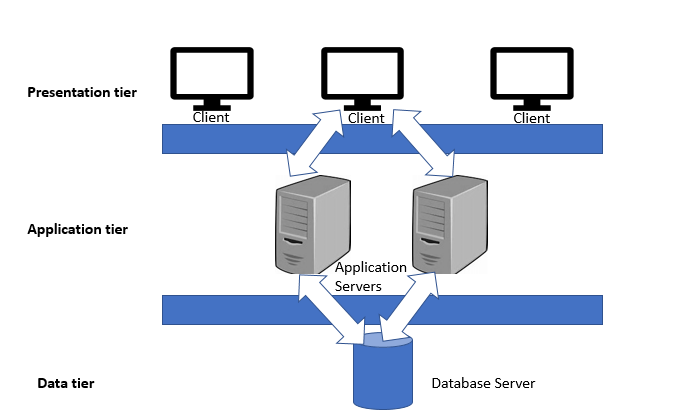The three tiers that are present in this architecture are as follows:
- The presentation tier
- The application or business logic tier
- Data tier
The diagram depicting the three-tier client-server architecture is as follows:

In a three-tier architecture, the different layers are developed and maintained as different modules, sometimes on different platforms as well. The following are the functions of each layer:
- Presentation tier: This is the first and topmost layer which is present in the application. This tier provides presentation services, that is presentation, of content to the end user through GUI. This tier can be accessed through any type of client device like desktop, laptop, tablet, mobile, thin client, and so on. For the content to the displayed to the user, the relevant web pages should be fetched by the web browser or other presentation component which is running in the client device. To present the content, it is essential for this tier to interact with the other tiers that are present preceding it.
- Application tier: This is the middle tier of this architecture. This is the tier in which the business logic of the application runs. Business logic is the set of rules that are required for running the application as per the guidelines laid down by the organization. The components of this tier typically run on one or more application servers.
- Data tier: This is the lowest tier of this architecture and is mainly concerned with the storage and retrieval of application data. The application data is typically stored in a database server, file server, or any other device or media that supports data access logic and provides the necessary steps to ensure that only the data is exposed without providing any access to the data storage and retrieval mechanisms. This is done by the data tier by providing an API to the application tier. The provision of this API ensures complete transparency to the data operations which are done in this tier without affecting the application tier. For example, updates or upgrades to the systems in this tier do not affect the application tier of this architecture.
Benefits of the three-tier architecture are as follows:
- Scalability and flexibility: The major advantage of this architecture is its scalability and flexibility. Each tier of this architecture is a modular component, that is, any kind of operations like changes or upgrades done to one tier does not affect or cause downtime to the other tiers. Less functionality performed by the client and no high-end configuration is required for client systems which are present in the presentation tier.
- Increased security: Splitting of tasks among the various tiers provides increased security to each tier.
Though three-tier architectural patterns offer several benefits, there are still limits on the scalability of the architecture when it comes to networks like internet which require massive scalability.
